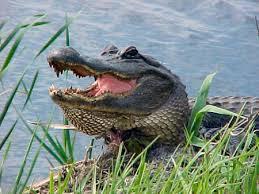Alligators and cockroaches: what do they have in common?
BOTH ARE LOANWORDS
What is a loanword? It sort of does what it says on the tin. It is a word one language loans or lends to another (though the lender doesn’t usually get it back, and no interest is paid). And the word loanword is itself a loan translation, purloined from German Lehnwort.
English is full of loanwords, as are most, if not all, European languages.
BOTH ARE FROM SPANISH
Our alligator combines the Spanish word for “lizard” lagarto, and the Spanish definite article el “the”. So, if you run the two together you get elligarto, which eventually was standardized as alligator, though previously spelt in at least a dozen different ways.
The word first appeared in its Spanish form lagarto in translations into English in the second half of the 16th century.  It made an early appearance in Romeo and Juliet, when Romeo is describing an impecunious apothecary’s shop:
It made an early appearance in Romeo and Juliet, when Romeo is describing an impecunious apothecary’s shop:
And in his needie shop a tortoyes hung, An allegater stuft, and other skins Of ill shapte fishes, and about his shelves…
That is the spelling in the 1599 Quarto; in the 1597 Quarto it is Aligarta, which illustrates just how indeterminate the spelling originally was.
In the first half of the 17th century we find Sir Walter Raleigh  and Ben Jonson still using the more Spanish spelling: Alegartos and Alligarta respectively. So why did the letters rt of that final -arto or -arta get swapped round to -ator? The OED suggests that it was by association with the agent suffix -ator, found in administrator, imitator, and so on.
and Ben Jonson still using the more Spanish spelling: Alegartos and Alligarta respectively. So why did the letters rt of that final -arto or -arta get swapped round to -ator? The OED suggests that it was by association with the agent suffix -ator, found in administrator, imitator, and so on.
This change of form suggests the influence of folk etymology: the process by which people change the shape of a strange, unfamiliar word to make it fit in with a more familiar word or pattern.
A CACAROOTCH
The ultimate shape of the word alligator suggests the influence of folk etymology on a mere suffix. With cockroach, the process transformed both elements of another Spanish word, cucaracha, into recognizable English ones: cock + roach. Many people will know the original word from the popular Mexican song:
La cucaracha, la cucaracha,
ya no puede caminar
porque no tiene,
porque le falta
las dos patitas de atrás.
(The cockroach, the cockroach
Can’t walk anymore
Because it hasn’t
Because it’s missing
Its two rear leglets.)
The unpleasant bug first appeared in print in 1624 in The Generall Historie of Virginia, New-England, and the Summer Isles by John Smith, a picaresque character, soldier, and Virginia’s first colonial governor:
A certaine India Bug, called by the Spaniards a Cacarootch, the which creeping into Chests they eat and defile with their ill-sented dung.
Its spelling, like that of alligator, inevitably went through several mutations, before folk etymology pinned it down to its modern shape. For a long time it was hyphenated, and appears as Cock-roach in Darwin’s Origin of Species (1859).
CHAISE LOUNGES
A more recent example of folk etymology in action is chaise lounge, adapted from the French chaise longue. The word longue looks odd in English (a rare parallel is tongue), but a chaise longue is ideal for lounging; the alteration therefore seems quite logical. (Some are more for show than serious lounging, like Le Corbusier’s iconic creation.)  While chaise lounge is predominantly American, and not recognized as a British spelling, the OED shows it first in an impeccably British source: an edition of The Times of 1807.
While chaise lounge is predominantly American, and not recognized as a British spelling, the OED shows it first in an impeccably British source: an edition of The Times of 1807.
Filed under: Dictionaries & Lexicography, Folk etymology, Loanwords, OED, Word Histories Tagged: Spanish words in English






